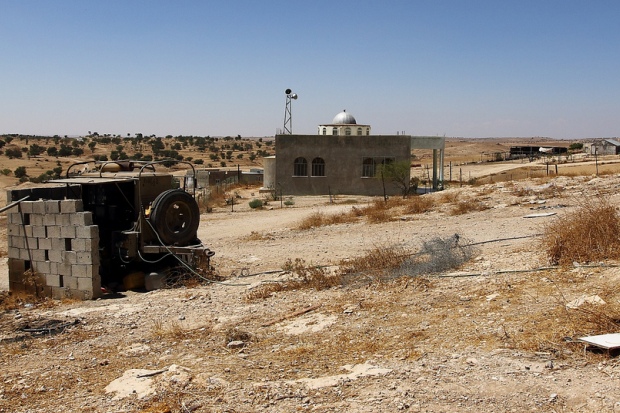Despite being sent there by the state in the 50s, the residents of Umm al-Hiran face immediate evacuation and destruction of their homes, in order to make way for Hiran, a settlement for national-religious Jews.
Last month, I visited along with a group of other +972 bloggers the village of Umm al-Hiran, in the northeastern part of the Negev, a few kilometers south of the Green Line. Residents were anxiously waiting a decision regarding the fate of their village, which was up for destruction by state authorities.
Umm Al-Hiran is one of roughly 40 unrecognized Bedouin villages, some of them predating the state itself. Those villages are deprived of basic government services, like running water and electricity; they are not entitled to zoning plans, such that every house built in these villages is at risk of demolition.
As it happens, Umm al-Hiram stands on the site of one of 10 new Jewish settlements the Prime Minister’s Office seeks to build in the area. In 2010, a state zoning committee recommended recognizing Umm al-Hiran, but Prime Minister Netanyahu’s office overruled that decision. The new settlement, called Hiran, will offer housing subsidies for national-religious families.
The Bedouin in this village have an especially strong case, since they were sent there by the state of Israel itself. Following the 1948 war, members of the Abu Al-Qian tribe were evicted from their lands in the western Negev (currently the site of Kibbutz Shoval). After settling in a temporary site, they were sent in the mid-50s by the military governor – who was put in charge of the Palestinian population after the war – to the Yatir area, where they currently live.
Last week, Umm Al-Hiran’s 500 residents received grim news: the National Council for Planning voted unanimously against the objections to the plan, filed in their name by Adalah and Bimkon, two NGOs. The Council said that the residents of the village have three options: to move to nearby Horah, to buy lots in the new Hiran (which are well beyond their means), or wait for new zoning plans for them (which will not prevent the immediate destruction of their village).
The state’s preferred option (according to comments given to the press) is to push the Bedouin population to the nearby town of Horah, which is unsuited to the agricultural lifestyle of many of Umm al-Hiran’s residents, and which suffers from a lack of employment opportunities and severe infrastructure shortages. In our visit to Horah, we saw garbage and animal carcasses scattered along the roads at the edge of over-populated town.
“We will not be displaced again,” Salim Abu al-Qian of Umm al-Hiran told us. “We agree to move back to our original lands near Shoval. We are not asking to move the Jews living there. We are ready to share the land.” Abu al-Qian explained that on top of the injustice, moving to Horah would leave his people with no futures and no means for survival.
The seven Bedouin townships are ranked at the bottom of Israel’s socio-economic index.
The construction of Jewish Hiran has been promoted by the “Or” movement – an NGO that promotes and facilitates the Judaization of southern and northern Israel. Or works in collaboration with the Prime Minister’s Office, the Jewish National Fund and the Jewish Agency. The Jewish National Fund is also involved in efforts to evacuate Palestinians from their homes in East Jerusalem and other parts of the Negev.


